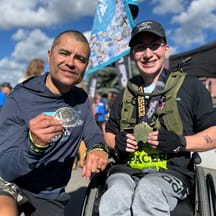Most people think of career growth in terms of moving up. But individuals can grow in their current role and develop through project assignments, stretch goals and coaching. Others may choose to work with their manager to prepare to move laterally to a new role to learn different skills.
Some may find work or life circumstances provide an opportunity to change the level of responsibility and take a step back. Others may choose to work on competencies to prepare for a promotional opportunity. In all scenarios, career development is defined by the individual. It's a personal journey influenced by one's skills, values and motivations.
At Ann & Robert H. Lurie Children's Hospital of Chicago, the organization is supporting employees in becoming their personal best from the moment they're hired through retirement. Life-long learning is critical for the growth of individuals and for the future of the organization, so the hospital provides flexibility with careers. Any career movement is considered successful. The individual drives the pace of career progression, moving faster or slower in line with his or her current life situation and career stage.
Assessing perceptions of a role
The hospital took on a career development initiative for administrative professionals, the second-largest job family in the organization. The work started with a gap analysis for career development processes, systems and tools, and leadership learned there was lack of clarity for the role's responsibilities. Some individuals thought tenure, not skills, were evidence of readiness for promotion.
This perception was reinforced by job descriptions that were similar for multiple roles, positions and levels in the organization. A needs assessment conducted with administrative professionals and managers identified several competency gaps. There were no role-based competencies and no formalized onboarding processes or career paths. There was also insufficient technology and resource infrastructure to support career development.
Creating a governance structure
With human resources and patient care executive sponsorship, the clinical and organizational department established a project to support professional development and career advancement opportunities for more than 700 administrative professionals. This includes those in administrative, clinical operational and academic roles. The project had multiple objectives:
- Develop role-specific competencies to define career paths
- Formalize the onboarding process for newly hired or transferred administrate professionals
- Facilitate networking, peer mentoring activities, initiate continuing education activities
- Map job descriptions to competencies, curriculum and compensation
Project leadership was established with a newly formed administrative professional (AP) governance structure, and the group was empowered to own the professional opportunities. The group formed four new committees:
- Competency and learning path
- Mentoring/orientation/onboarding
- Recognition
- Learning network
Committee chairs sit on an advisory council, along with administrative professional members at-large, advisors from operational leadership and human resources. Members of the clinical and organizational development department serve as advisors to the committees and council to facilitate group formation. They serve as guides for competency development, and they help remove barriers to committee work.
Career networking and support
To jump-start the work, clinical and organizational development staff designed orientation boot camps for AP committee chairs and AP members. The department assisted with the design and implementation of quarterly networking events called FaceTime. These events provide learning, networking and recognition activities.
Networking topics include drafting elevator pitches, tips and tricks for better job performance and overviews of online resources. An online career development portal houses an event calendar for brown bag learning sessions, newly hired AP orientation breakfasts and career development resources.
To support development of the AP governance structure, luncheon meetings with committee chairs provide a venue to hear about challenges and provide support. At the one-year mark, a retreat for the team focused on managing complex change—committee chairs and members met to assess vision, skills incentives, resources and action plans to support career development for administrative professionals. At the end of the retreat, committee members reflected on their accomplishments and identified next steps for their work.
Developing competencies
Developing competencies for administrative professionals is foundational for the development of career pathways. These global competences are also relevant to all 700 staff members, regardless of their roles:
- Technical
- Intrapersonal
- Personal leadership
The AP competency committee then defined core competencies for administrative processionals in five areas:
- Communication
- Service
- Continuous learning
- Accountability
- Professionalism
To support the development of detailed, role-specific competencies, the organization purchased an online health care job description and competency library. Consultation services helped define competencies for administrative professionals in the first and largest medical department. This work group consisted of administrative professionals in representative roles, administrative managers, and clinical and organizational development staff. Together, the role-based competencies were selected and prioritized to update job descriptions, review compensation, and develop career pathways and curricula for five administrative professional roles.
To support learning, the clinical and organizational department has collaborated with cross functional operational leaders to develop policies and implement technology solutions to enable learning from any mobile device at any time. Legal counsel advised on policy revisions and how pay would be managed for non-exempt employees. The policy describes compensation for time to complete mandated education and when time is uncompensated for voluntary education.
Making the investment in people
Research across generations and industries consistently indicates challenging work opportunities, ongoing opportunities for career growth, and effective learning and development are critical factors to employee job satisfaction and engagement. At Lurie Children's, career development is a shared responsibility between the organization, leaders and employees. The organization invests in resources, processes, systems and tools to support career development in all roles.
Benefits of this approach include:
- Easier recruitment
- Better retention of an engaged workforce
- Knowledge transfer through coaching and mentoring
- Increased skill and knowledge development
- Workforce is prepared to advance into roles the organization needs
Leaders and employees become their personal best and benefit from increasing performance through all stages of their careers, from the moment of hire until retirement.


